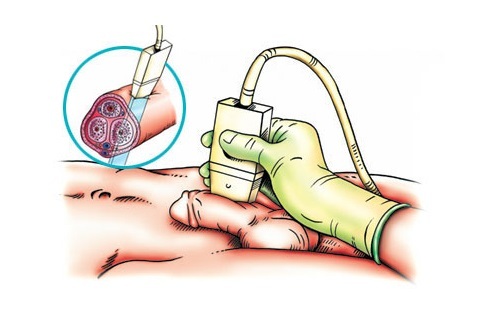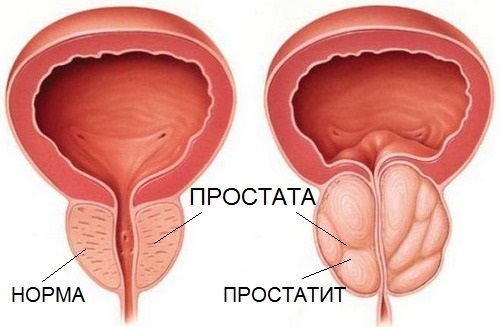Why and how is the dopplerography of the vessels of the penis?
According to medical statistics, about 40% of men of childbearing age experience difficulties in achieving a full erection. The penis is either not hard enough to penetrate, or spontaneous premature ejaculation occurs. Both pathologies belong to the field of impotence or the violation of sexual function( erection).Often the problem lies in the insufficient arterial-venous circulation in the pelvic area.

Dopplerography of the vessels of the penis makes it possible to determine the state of the blood flow and the causes of erectile dysfunction.
Erection is achieved by filling with arterial blood of special anatomical structures of penis-cavernous bodies. Due to the high rate of arterial blood flow and the low rate of venous outflow, an erection is provided. As a result of a violation of the rate of return of blood through the veins or circulatory failure of the penis, the sexual function decreases. Dopplerography is designed to put an end to the issue of the origin of erectile dysfunction.
Contents
- 1 Indications for the
- 2 Study Contraindications
- 3 Preparation for the
- 4 study Description of the study
- 5 Criteria for evaluating the results of the
survey Indications for the
study Indications for conducting the dopplerography of the penis are several:
-

Erectile dysfunction is one of the indications for dopplerography of the penile vessels
Erectile dysfunction of any origin.
- Congenital and acquired injuries and deformities of the penis. Curvature and the like.
- Volumetric neoplasms of the penis. Tumors can directly affect the nature of the vascularization of the "genital organ".In addition, the degree of blood supply of the neoplastic structure is determined. This is important for identifying the type of tumor process.
Read more: Erectile dysfunction of vascular genesis: diagnosis and treatment
The following changes in the penile and its structures can be detected during the study:
- arterial blood supply disorders in the cavernous bodies;
- change in venous outflow rate;
- compression of the vascular structures of the penis;
- narrowing of the veins and arteries of the penis;
- decreased the elasticity of veins and arteries;
- presence of foreign bodies and cicatricial changes in the structure of the urethral canal;
- atherosclerosis of the penis, fibrosis of anatomical structures.
Contraindications
Contraindications as such does not exist .The procedure can not be performed if the patient is unable to remain in a lying, immobile state. This may be due to the young age of a person, the presence of neuropsychiatric problems, etc. However, this contraindication is relative. If necessary, it is enough to inject a sedative. Also, it is not recommended to carry out a study with a general severe condition of the patient.
Preparation for the
study No specialized preparation for dopplerography is required.
-

Before the procedure it is necessary to conduct intimate hygiene
It is recommended to thoroughly clean the penis and inguinal area immediately before carrying out the manipulation.
- In addition, half an hour before the procedure, it is necessary that the bladder is partially filled. With an empty organ, the results can be blurred and inaccurate.
- A few days before dopplerography, it is necessary to abandon alcoholic beverages, especially beer, and smoking, so as not to cause a secondary change in the blood flow of the vessels of the penis. Otherwise, the results of the survey will be false.
Description of the study
The patient undresses, takes off his underwear and lies down on the couch. The doctor lubricates the area of the penis with a special gel and applies an ultrasonic sensor. By its nature, Doppler ultrasound is a variation of the ultrasound of the vessels. After a thorough examination of the unregulated penis, a special preparation is injected into the cavernous bodies to induce a spontaneous erection.
Unlike ordinary erection, induced erection does not start so quickly and develops for a longer time, so that a diagnostician can track the nature and intensity of blood flow in each phase. The duration of the study is 30-40 minutes. Every 3-5 minutes, measurements are taken, after which the doctor fixes the results in the protocol.
Instead of administering the drug to the body, it is possible to take Viagra and its analogues. The use of sedative pharmaceuticals is not recommended, since the risk of stopping potency is great. Depending on the clinic, other methods of stimulation are possible, for example, manual, viewing pornographic materials. However, these methods do not give a reliable result: a natural erection is unstable, develops rapidly, so there is no way to investigate every phase of it. In addition, the procedure lasts 30-60 minutes, so long to keep the potency naturally is impossible.
The results are given to the patient after 20-30 minutes, at the end of the examination. As a result of the manipulation, the following diseases and pathological conditions can be identified:
- trauma of vascular structures( venous and arterial);
- thrombosis of the main vessels of the penis;
- cavernous fibrosis;
- neoplastic processes in the penis;
- atherosclerosis of the vessels of the penis( due to occlusion or stenosis);
- Peyronie's disease( curvature of the penis).
Read: Erectile dysfunction therapy 1, 2, 3 lines
Criteria for evaluating the results of the
survey During the study, a number of factors are determined:
- echogenic indexes of penile tissues and organ vascular structures;
- features blood flow in deep-lying and outer areas of the penis;
- speed of circulation, features of venous valves.
Normal parameters include:
- Systolic rate of arterial blood supply within 30-50 centimeters per second. A smaller indicator indicates in favor of insufficient filling of cavernous bodies with blood and, consequently, an erection either does not occur at all, or it is excessively weak.
- The diastolic velocity of the arterial blood flow, which is about 5 centimeters per second. Ideally, it is desirable that this indicator is in the zero region.
- The pulsating index is within, approximately, 4 and no more.
- Resistance index. The indices below 0.85 indicate erectile dysfunction.
In addition, the rate of venous outflow is determined. With excessive indices, the erection is unstable. In general, the doctor decides on the results. It is almost impossible to understand by your own forces.
Dopplerography of the vessels of the penis is an indispensable study, there are no alternatives. It provides an opportunity to assess the nature and speed of blood flow, to identify the causes of erectile dysfunction. After carrying out the manipulation, you should consult a doctor for decoding. All questions should be addressed to the treating specialist. Trying to understand the nature of the process yourself is a waste of time and energy.
Read: Restoration of erectile function by the method of LOD-therapy
Recommended for viewing:



